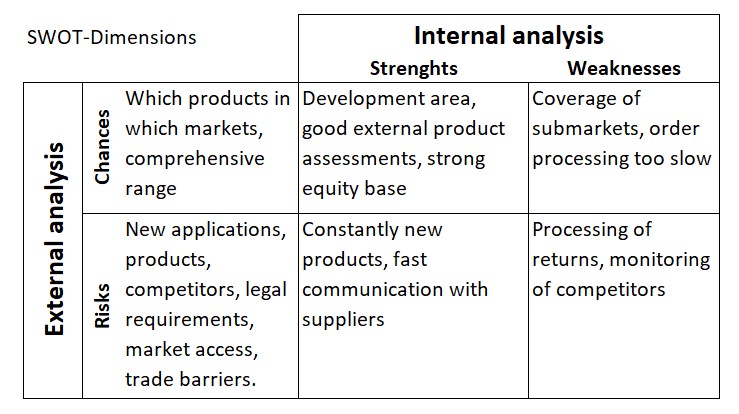SWOT Analysis
SWOT analysis is intended to produce a structured representation of the strengths and weaknesses of the organization under consideration and to contrast these with the opportunities and threats in the four environmental spheres (cf. the post “Environmental Changes are Crucial for Management Control“).
The purpose of the opportunities/risks and strengths/weaknesses assessment is to,
-
- create the basis for strategic planning and
- define the success potentials necessary for their realization.
A SWOT analysis is primarily prepared by the top management of an organization. They determine whereto the company / organization should develop and assess whether the targeted development will be feasible in the medium-term time horizon. The decisions derived from a SWOT analysis form the planning template for the strategic and operational planning executives.
Subordinate management levels should be able to derive which services and products the company should use to achieve strong positions in nominated markets and which results should be achieved in the process (corporate policy determinations).
The assessment and documentation of external opportunities and risks and the evaluation of the company’s own strengths and weaknesses form the input for strategic and medium-term planning.
Analysis of the environment and of the own position
The widely known SWOT matrix shows the initial questions of the analysis:
Business environment: In which environmental areas are opportunities for new products and services suspected and which threats could prevent success?
Own development direction: In which product/market combinations does the company see its strengths for expanding its market position, and which of its own weaknesses could prevent success?

The above questions on opportunities and risks are examples. The same applies to the assessments of the strengths and weaknesses of the own company.
If a company’s management creates its own SWOT analysis and records its findings in the matrix, the subsequent management levels can align their strategic plans and, above all, the development of future success potentials accordingly.
How the strategic and medium-term plans for the entire company are derived from the SWOT analysis is the subject of the following posts:
